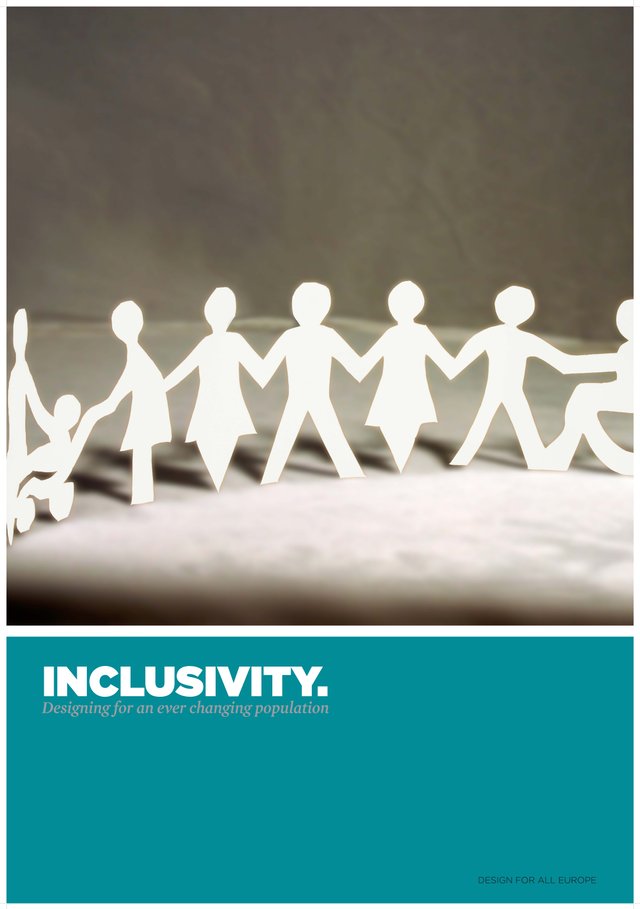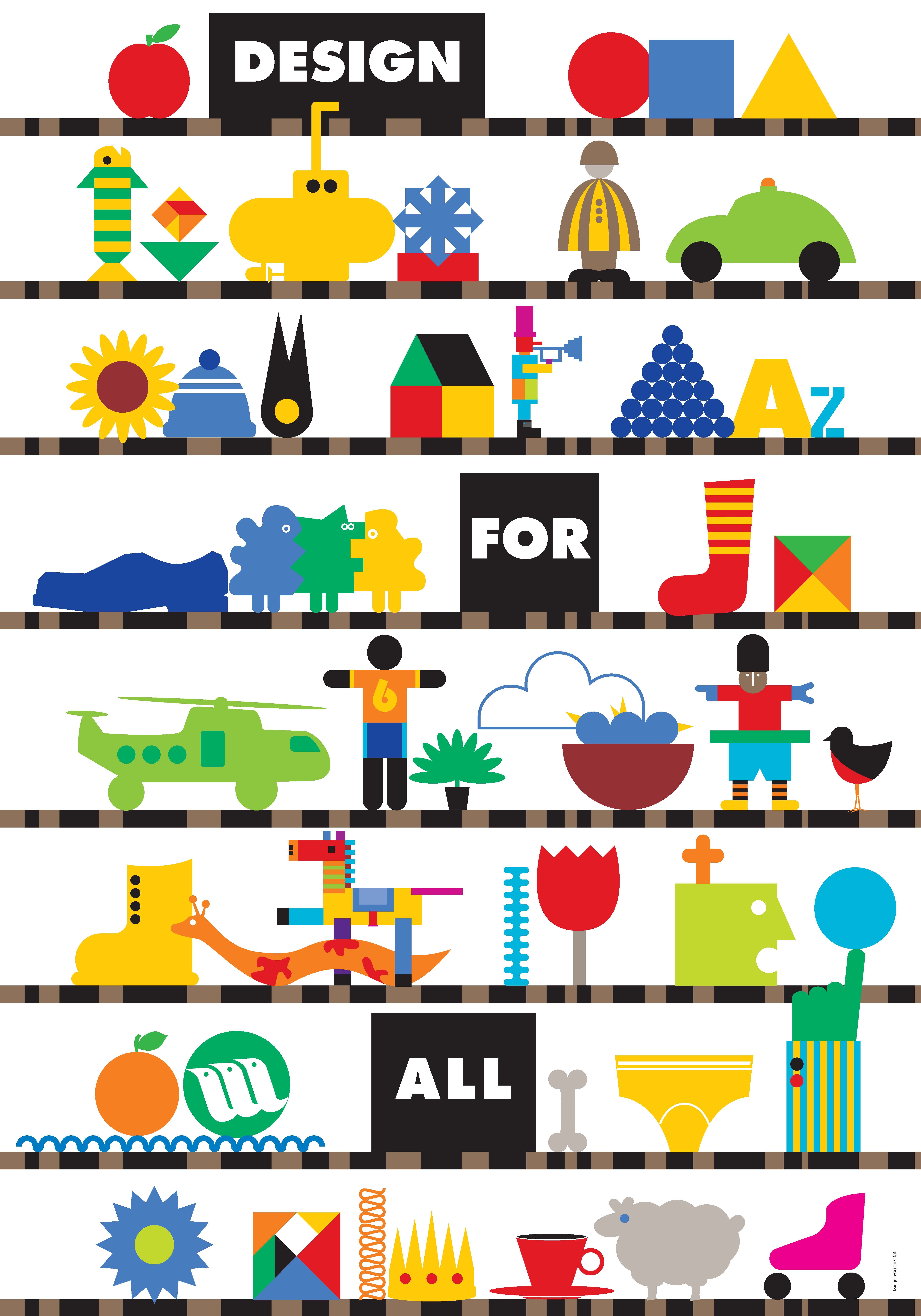Hi everyone. Today I will start trying to give you a little information about what is Design for All. I won´t manage to do this in one short post, so, if you are interested, just hang with me. More will come in time.
When I think about writing a post on Design for All that was to describe the development of Design for All, I immediately find myself in a situation that is not easy. How can I crystallize the development of Design for All when that development takes such different forms from one country to another and to all intents and purposes defies segmentation into bite-sized milestones?
Most of these milestones are concerned with organizational interests. They are significant in relation to the development of Design for All because every practical approach - and, like all design disciplines, Design for All is a practical approach, as well as a philosophy - requires and organizational infrastructure to further its interests.
What transpires immediately from a cursory glance at these milestones is their eurocentric focus. While this is natural enough, I do not want to give the impression that the relevance of Design for All is necessarily restricted to any particular model of socio-economic development. Indeed, the geographical area that we know as Europe contains a wide diversity of models. Some of which have more in common with one another than others.

This picture and the other ones following here in this post are all from a poster competition we did a few years ago with Icograda, the International Council of Grafic Design Assosiations, where we had hundreds of applications from all over the world showing how different people in different countries and cultures see Design for All. This are just a few examples for you today.
EIDD (as you all know, or can find out from my introduction post, I am one of the Vice Presidents of EIDD Design for All Europe, and this is also why this Organisation will be mentioned over and over again in my posts (can´t help it, sorry! but when it is about Design for All it is also about EIDD :-)) did not “invent” Design for All: the EIDD was originally established because design and its practizing professions, which can make such an important difference to the quality of everyone’s life, were nevertheless often leading the way in manifestations of appalling complacency and ignorance. Something had to be done about improving design’s track record in the area of disability and the founders of EIDD succeeded in gathering together the necessary critical mass from several European countries to establish the EIDD in 1993.
Almost immediately (at the Bonn symposium in December of the same year), EIDD started discussing Design for All, as it was rapidly apparent that there were (and still are) two ways of applying the practice of design to improving things for disabled people. Let’s call them, for the sake of argument, the straightforward approach and the complex approach. In design parlance, we might distinguish them as “Design for Disability” and “Design for All”, though their ramifications in practice indicate that they are perhaps best described as “design for the inclusion of identified categories”, or “exclusively inclusive design”, and “design for holistic social inclusion”, or “inclusively inclusive design”. The one is straightforward, because it avoids the many and varied issues of human diversity and the ethical responsibilities of creativity applied for utilitarian purposes, preferring to aim straight at the objective of a clearly-defined and sometimes narrow (these days often increasingly narrow and highly specialized) target; the other is complex, for the very reason that it is built on the synergic concomitance of these and many other factors, influences and variables: in short, like nature, the world and life itself, it is complex, though not necessarily complicated.

The straightforward approach
The straightforward approach is the one that could reasonably have been expected of any competent designer, architect or other exponent of the creative professions already at the time when EIDD was established. The first step is to identify a problem, which may be in the way a product is used (usability), the way an environment or building is accessed (accessibility) or the way a communication system is understood (comprehensibility). Having identified the problem, a competent professional should next explore the range of potential users of the product, environment or communication system, then start drawing up targeted design hypotheses to respond to the identified challenges.
In this respect, the individual disabled person, with an identifiable life situation requiring improvement, and the community of disabled people sharing comparable life situations both constitute rather clearly identifiable targets for the design process. The result is that designers have developed a series of specializations that have first related rather closely to the sciences of rehabilitation and have tended more recently to develop synergies with information and communication technologies (ICTs), as tools for enhancing the quality of life for identifiable disabled groups.
Of course, the process of catering for an identified need with a clear design process is not (and never has been) quite that simple in the real world. Numerous other factors have a bad habit of getting in the way, factors that range from the realistic to the patently absurd (but not less influential). The stresses induced by the perceived need to shorten products’ time to market have made it increasingly difficult for designers to take the necessary time out to ponder their creations, consider their subsidiary effects (unplanned usages, like using a pen as a telephone dialer or a back-scratcher, for example) and involve real focus user groups in preliminary and ongoing development evaluations… and this is a realistic development that we are expected to accept in respectful silence, because it is dictated by curiously ineffable “market forces”. But the influence of the patently absurd is also there for all to perceive: one example for all is the restaurant owner who resists adapting his premises to make them wheelchair accessible out of an illogical and rather disgusting prejudicial fear that disabled patrons would scare his “normal” able-bodied clients away. These are different problems which require different answers. In the first case, there is a real need for the methods and advantages of good design to be taught not only to future designers and architects, but also to those whose decisions dictate the scope of their activities: marketing, management and public administration are fields that spring to mind immediately. In the second case, the need is for more useful education from infancy onwards, whose purpose must be to reduce and eventually eliminate prejudices.
The straightforward approach has actually had a rather good innings in the last twenty to thirty years. It has achieved major milestones of its own, particularly in Europe and the United States. Since the war, advances in medical science have made it possible to live longer and healthier lives despite having a permanent disability. Also, the writing has been on the wall for Europe and North America ever since the post-war baby boom: sooner or later, the population was going to get old, so some form of allowance had to be made. The European Union responded by gradually factoring elements of specialized research for disabled and elderly applications of existing and future ICTs into its framework research programs. The result has been the growth of a rather large research community with a focus on “special needs” solutions that has done some magnificent work in facilitating everyday life for many categories of people, by generating everything from advanced prostheses and implants to improved low floor buses and more user-friendly advanced consumer electronics. In the United States, the human rights legislation embodied in the Americans with Disabilities Act moved the architectural profession to come to terms with the challenge of access to the built environment. In both cases, as indeed elsewhere in the world, notably Japan, another society that is having to learn to cope with aging, such thinking has led gradually to the development of a design approach that attempts to broaden the scope of potential users of its end products, starting from the principle of including disabled people.

Design for All
The complex approach, or Design for All, has a parallel history. As the EIDD’s Stockholm Declaration© 2004 states:
“Design for All has roots both in Scandinavian functionalism in the 1950s and in ergonomic design from the 1960s. There is also a socio-political background in Scandinavian welfare policies, which in Sweden in the late 1960s gave birth to the concept of ‘A society for all’ referring primarily to accessibility.”
It is no coincidence, obviously, that the authority for this statement comes from Finn Petrén, former President of EIDD, who has long played the leading role in the socio-political development of Design for All in Scandinavia, until quite recently as Director of the Nordic Council on Disability Policy, then as President of EIDD Sverige and co-ordinator of Sweden’s major national Design for All program.
The first and fundamental difference between the two approaches is the attitude taken towards the world and its inhabitants. Though both approaches aim at achieving inclusion, the straightforward approach developed from a matrix of design for disability, which leads it to tend to continue targeting inclusion by identifying categories to be included and dealing with them, one by one or group by group, as the need is perceived to arise, while Design for All developed from a socio-political matrix in which the foremost emphasis has always been on social inclusion as such, rather than on one or more identifiable groups of people to be included, and design has been found to be the most efficient and effective tool to achieve this purpose.
No simple label is perfect and Design for All is no exception: its detractors have long enjoyed repeating the remarkably persistent, though eminently foolish myth that Design for All must fail in the attempt to make “one size fit all”, demonstrating an avoidable tendency to attribute literal meanings to words, rather than study the messages they convey, and a somewhat obstinate refusal to study the discipline and its aspirations. Be that as it may, this criticism was already answered in the statement adopted by the EIDD’s Bonn Symposium in December 1993:
“[…] there will always be a need for design directed towards meeting special needs.”
The approach adopted by the complex approach, or Design for All, may appear when first studied to be quite similar to that of the straightforward approach. Once again, the first step is to identify a problem, followed by exploring the range of potential users, consulting with them and then drawing up targeted design hypotheses to respond to the identified challenges. The difference lies in the definitions attributed to the terminology being used.
Thanks to PETE for all your inputs to this above :-)
I leave you with this today to think about it, but it is
TO BE CONTINUED

Have a great day all you ´Steemers` out there!
Really cool!
Downvoting a post can decrease pending rewards and make it less visible. Common reasons:
Submit
Thanks! It is nice to get positive feedback! Really appreciated
Downvoting a post can decrease pending rewards and make it less visible. Common reasons:
Submit
Amazing!!!!!!!!!!
Downvoting a post can decrease pending rewards and make it less visible. Common reasons:
Submit
thank you
Downvoting a post can decrease pending rewards and make it less visible. Common reasons:
Submit
Congratulations @markushaas! You received a personal award!
You can view your badges on your Steem Board and compare to others on the Steem Ranking
Vote for @Steemitboard as a witness to get one more award and increased upvotes!
Downvoting a post can decrease pending rewards and make it less visible. Common reasons:
Submit